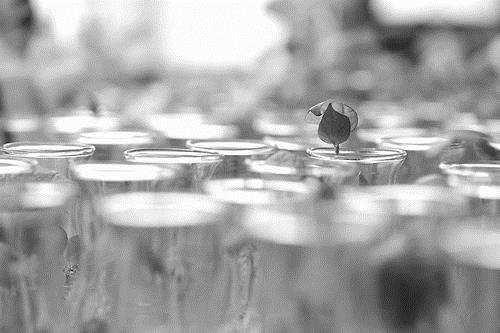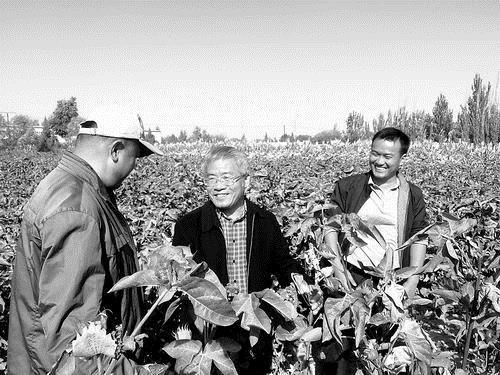
▲Cotton seedlings in National Key Laboratory of Crop Genetic Improvement

▲Zhang Xianlong (center) inspects the growth of sea island cotton in Xinjiang
Recently, Prof. Zhang Xianlong, head of Cotton Genetic Improvement Team, HZAU, and his team, together with overseas research teams , published their latest research findings on Nature-Genetics online. They jointly analyzed the reference genome sequence of allotetraploid cultivated upland cotton and sea island cotton, which provided important reference for cotton genome evolution and functional gene research.
One significant economic crop
“Cotton could be sowed either in spring or in summer after the harvest of wheat, since it was one of the key economic sources for Chinese farmers in the 1980s and 1990s and the sole plant whose fruits could be called flower,” Professor Tu Lili, the first author of the paper, from cotton genetic improvement team of HZAU, told the reporter that almost every family planted cotton in Jianghan Plain of Hubei Province and to south of Tianshan Mountain in Xinjiang Province in the past. “It was just like the world of cotton at the fields”, she said.
Historically, there were four cultivars ever cultivated on a large scale in China, namely, upland cotton, sea island cotton, Asian cotton and straw cotton. Nowadays, most cotton grown in China is upland cotton, and there is a small amount of sea island cotton that grows in Xinjiang.
Today, as one of the main economicfield crops in China, cotton has an annual planting area of 70 million mu(1mu≈666.67m2), an annual production of 7 million tons, and an output value of exceeding 110 billion yuan per year. Cotton has always been the undivided focus of international research circles due to its role in national economy and people’s livelihood.
Although, upland cotton cultivation has a history of more than a hundred years in China, breeding work is often moving slowly like “wading across the stream by feeling the way”. Prof. Zhang Xianlong, correspondent author of the paper, said to the journalist that 95% of the raw cotton comes from upland cotton. “It has strong adaptability and high yield, but its fiber length is short and prone to Verticillium wilt. In addition to upland cotton, sea island cotton, is introduced from abroad as well, with good properties such as long fiber, thinness, strength and resistance to Verticillium wilt, but it has poor adaptability. So itsmain growing area is limited to some parts of Xinjiang.
In order to obtain long, thin and strong fiber and meanwhile ensure production, the research team proposed an idea, which is to introduce the genes related the high quality fiber from sea island cotton into the upland cotton, and use the sea island cotton genetic resources to improve the quality of the upland cotton fiber and disease resistance.
Last March, their previous research result, “Asymmetric Subgenome Selection and Cis-regulation Divergence in Cotton Acclimation”, was published in Nature-Genetics. They summarized and comprehensively analyzed the molecular mechanism of traditional breeding work at the DNA level, and they found out some key gene loci, such as the genes that make cotton fiber long and white, thus improving the predictability of cotton breeding.
“One team” and “one cotton boll”
Cotton research of HAZU could be traced back to the 1930s, and scholars like Prof. Yang Xiandong and Prof. Sun Jizhong had built generations of cotton research teams. Current team, led by Pro. Zhang, aiming at the international frontier, mastered the mature cotton tissue culture technology system, and won a number of international firsts, including the first regeneration plants from wild cotton tissue such as Gossypiumraimondii, Gossypiumklotzschianum, and the first regeneration plant from wild cotton protoplasts such as Gossypiumklotzschianum.
Based on this, a group of new cotton cultivars with early maturity, high yield, high quality and multi-resistance have been developed via distant hybridization, cell engineering and traditional breeding evaluation techniques.
“One map” to Understand the Cotton Quality Improvement
“It’s a kind of natural textile fiber with good hygroscopicity”, Tu told the reporter. “Under normal circumstances, cotton fibers,with its moisture content of 8% - 10%, can absorb moisture from the surrounding atmosphere. Hence, people will feel soft but not stiff when touching the fibers. In the opposite case, if the cotton cloth humidity increases and the surrounding temperature becomes higher, the water contained in the fibers will evaporate and disperse, leaving the fabric to maintain water-balanced state and to give people comfort.”
There are over 90% of the annual outputs of natural textile fibers in the world from allotetraploid cotton, which are upland cotton and sea island cotton. Upland cotton is widely planted all over the world for its high yield, while sea island cotton is highly valued for its excellent fiber quality.
Dr. Wang Maojun, the first author of the paper and also a member of the team, introduced that it’s been the long-term goal of HZAU team to introgress genetic fragments of sea island cotton that control excellent fiber quality into upland cotton to improve the fiber quality of upland cotton.
“Although a series of functional genes from sea island cotton have been cloned, we are still unclear about the differences that exist between the two cotton genomes and genomic fragments that control the formation of excellent fiber quality in sea islandcotton.” Wang said, despite the allotetraploid cotton draft genomes that have been published, it is almost unlikely to compare directly from the whole genome level in terms of the poor quality and integrity of assembly.
They integrated single-molecule real-time sequencing, BioNano optical mapping, and high-throughput chromosome conformation capture techniques to assemble the fine genome sequences. There are 55 times and 90 times of quality increase of upland cotton genome and sea island cotton genome, respectively, in comparison with the newly published draft genomes for their immense advancement in continuity and integrity.
From Zhang’sview, this study successfully assembled highly repetitive genome regions, and a large number of structural variations were found between them by comparing the genomes of two cotton tetraploid species. There were 26 pairs of chromosomes in each of the two allotetraploid cultivars, and large paracentric/pericentric inversions have been observed in 14 chromosomes of the two cotton cultivars in the research. It demonstrates “tremendous discrepancies in the genomes of the two cotton cultivars”.The genetic introgression lines between upland cotton and sea island cotton were analyzed, with 13 genetic loci controlling fiber quality being identified, and the mechanism of gene loci expression regulation being explored.
Tu also told the reporter that this study served as a reference for the future inter-species introgression breeding of upland cotton improved by sea island cotton. It indicates that this genome map solves the problem of “tool” for cotton researchers, having the noticeable significance for expediating the process of researchon improving the quality of cotton.
